Scandinavian furniture, or “scandi furniture” as it is often referred to, has taken the design world by storm in recent years. With its clean lines, functional features, and minimalist aesthetic, it has become a popular choice for those seeking a timeless, yet modern look. But what is the origin of this design sensation?
The Scandinavian design movement emerged in the early 20th century, with a focus on quality craftsmanship and functionality. In the aftermath of World War II, Scandinavian countries such as Denmark, Norway, and Sweden sought to rebuild their economies by producing affordable yet stylish furniture. This led to a rise in design schools, which focused on training designers to create innovative, functional, and beautiful pieces.
One of the key figures in the Scandinavian design movement was Arne Jacobsen, who is often referred to as the father of Danish design. Jacobsen was a visionary who designed everything from buildings to furniture, with a keen focus on functionality and simplicity. His iconic Egg Chair, designed in 1958, is still considered a masterpiece of modernist design.
Another significant contributor to the rise of scandi furniture was Alvar Aalto, a Finnish architect and designer. Aalto believed that design should reflect the needs of the user, and his furniture designs were made to be comfortable, practical, and affordable. His most famous piece is the Paimio Chair, designed in 1931 for a tuberculosis sanatorium.
As the Scandinavian design movement gained momentum, the principles of simplicity, functionality, and quality craftsmanship began to permeate all aspects of design. Furniture designers began to experiment with materials such as wood, leather, and steel, creating pieces that were both beautiful and durable. The Scandinavian aesthetic became synonymous with clean lines, natural materials, and understated elegance.
Today, scandi furniture continues to be popular around the world, with designers like Hans Wegner, Nanna Ditzel, and Børge Mogensen all contributing to the movement. The popularity of Scandinavian design can be attributed to its ability to blend seamlessly with any interior style, whether it be modern or traditional. Scandi furniture is known for its versatility, as it can be dressed up or down depending on the occasion.
In conclusion, the rise of Scandinavian furniture can be traced back to the early 20th century, when Scandinavian countries were looking to rebuild their economies. Design schools focused on training designers to create functional, affordable, and stylish furniture, which led to a movement that has become a global sensation. Today, the principles of simplicity, functionality, and quality craftsmanship continue to be at the heart of scandi furniture design, making it a timeless and versatile choice for any interior.

